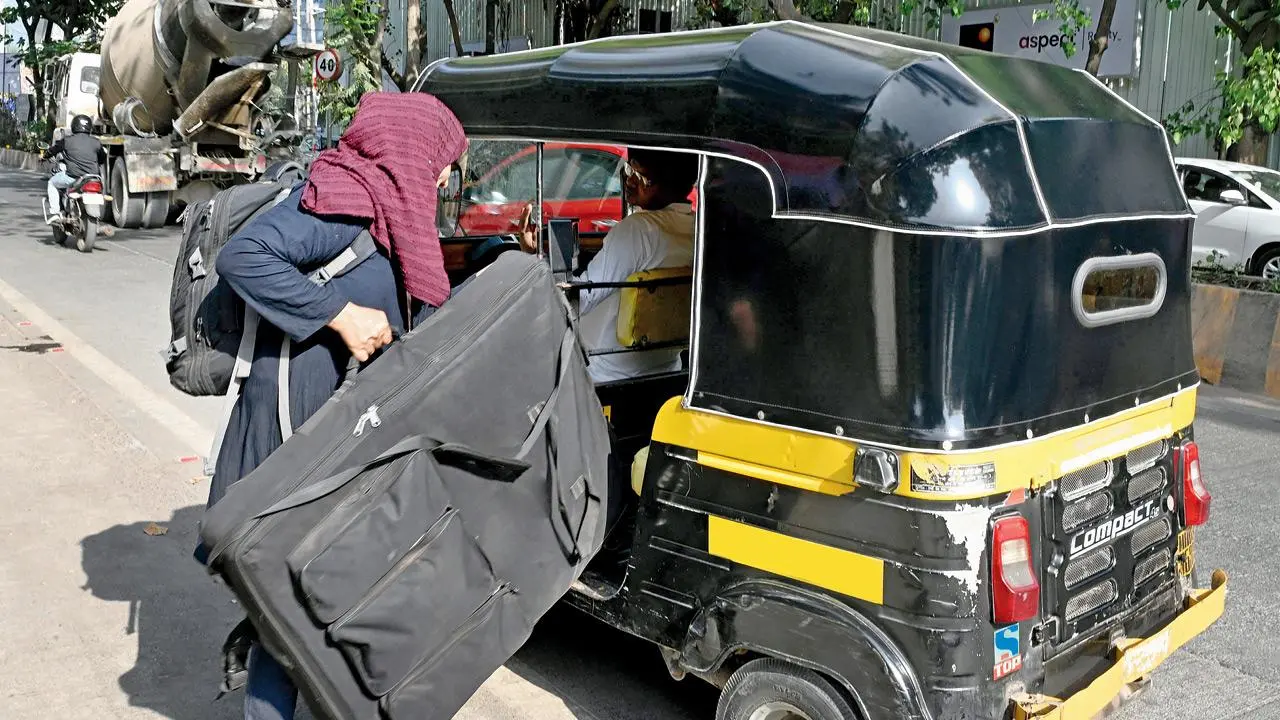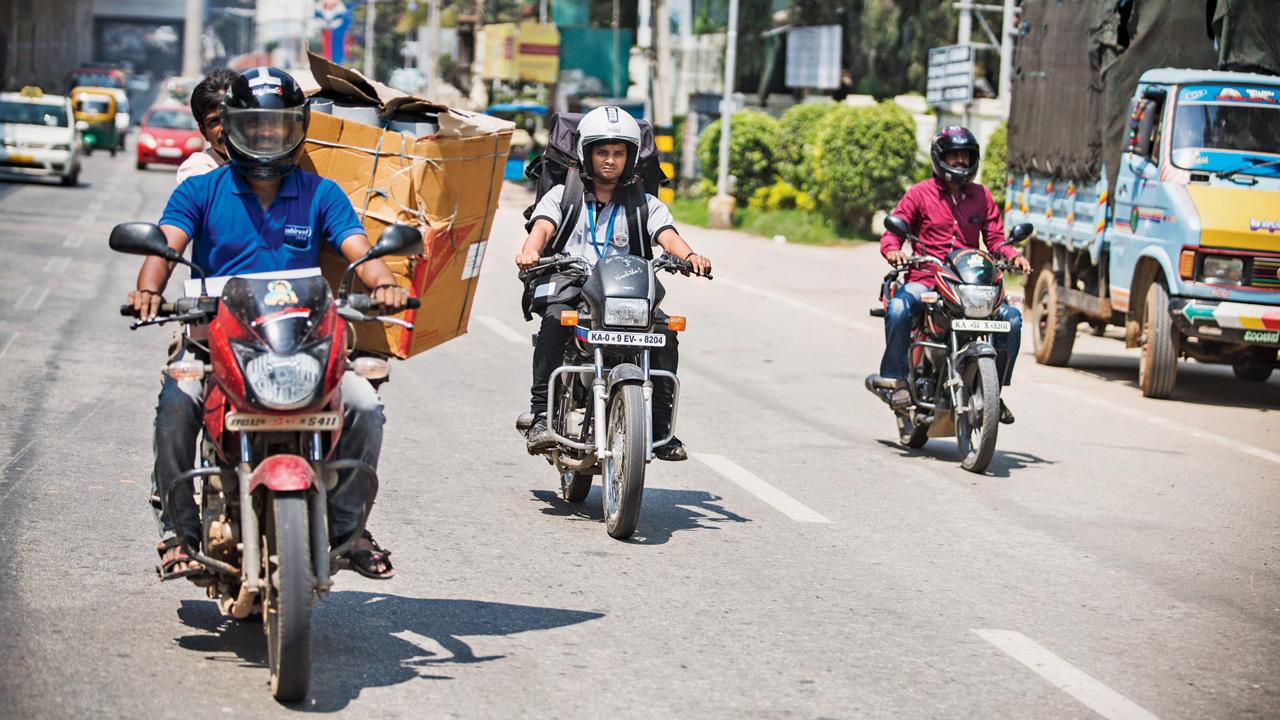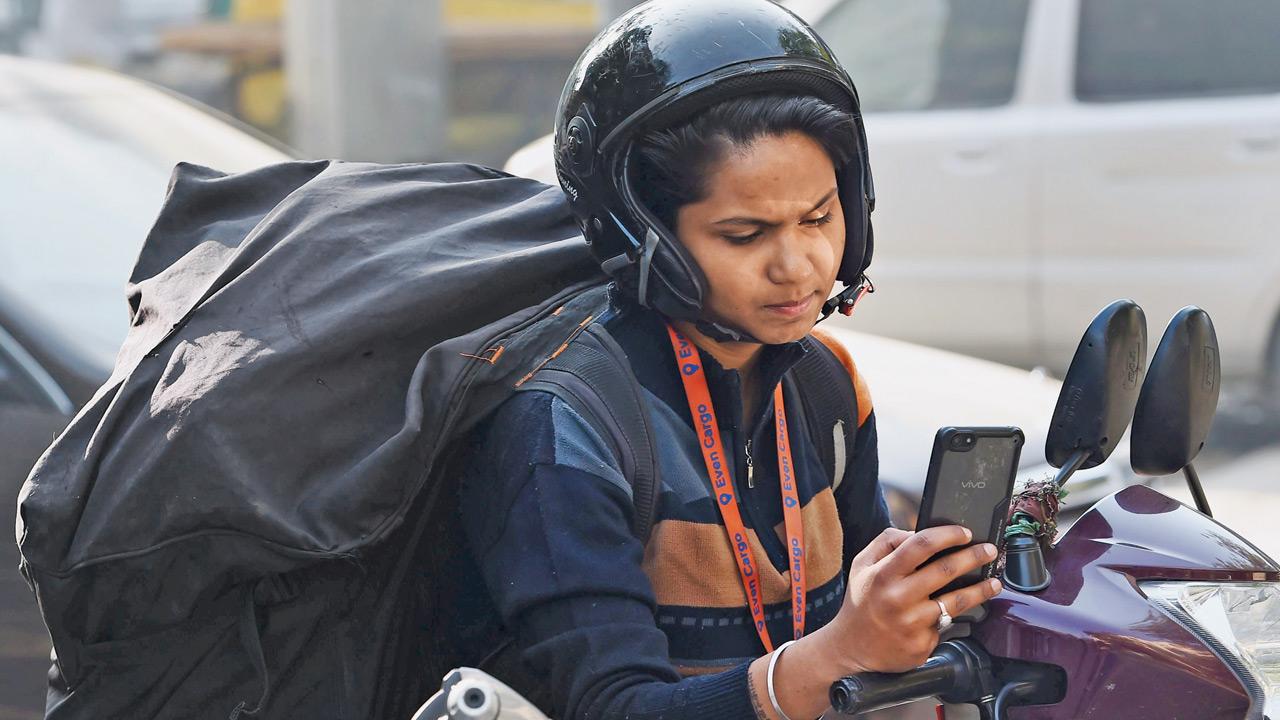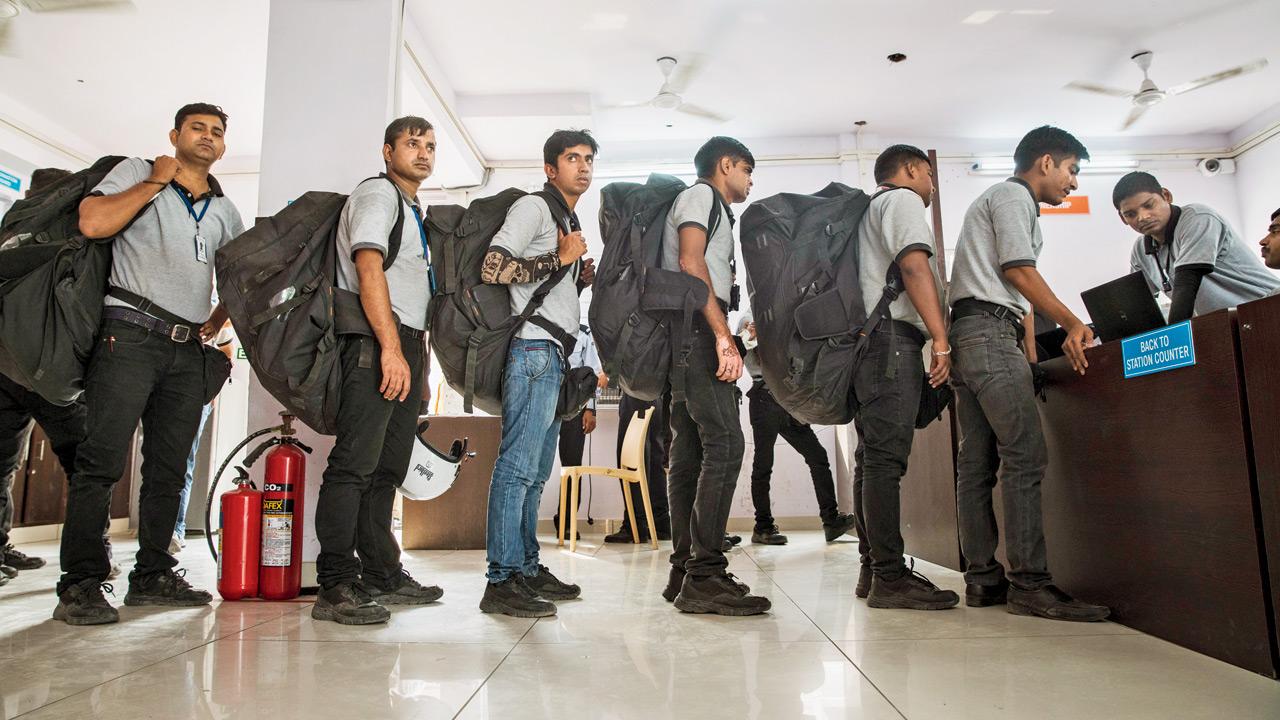As we celebrated Labour Day this week, Sunday mid-day spoke to gig workers who break their backs carrying massage tables, groceries, and even furniture across the city. They have no insurance, barely any time off, and no legal protection. Aren’t we labourers too, they ask

Gig workers, such as Aanam Khan (name changed, above), are classified as ‘partners’, not employees, and are thus not eligible for basic workplace protection — including limits on the weight they carry and better health coverage. Khan, for instance, carries 36 kg on her back across Mumbai to offer professional massage services. Pic/Kirti Surve Parade
So many of us breathed a sigh of relief on May Day, glad to put up our feet and enjoy the mid-week holiday. And how many went on apps to call for a massage at home, or grocery and food deliveries, with no thought as to why the workers providing these services were working on a day that pays tribute to the labour force?

Aanam Khan (name changed), a massage therapist with a popular home service app carries a 25-kg foldable bed, along with an 8-kg backpack with her wherever she goes. Pic/Kirti Surve Parade
India currently has one crore gig workers, which is expected to rise to 2.35 crore by 2029-30, according to a NITI Aayog report released in November 2024. Despite this massive number, the country is yet to legally recognise them as “labour”. Without the protection this tag offers them, gig workers carry the heavy burden of exploitation.
When Anjali Kelkar, a managing partner at Magpie Brand Solutions, booked a massage therapy session through a popular professional home services app, she expected quick relief from her stress. Then the masseuse turned up in tears. Turns out, Kelkar’s “healer” needed healing, too.

Many gig workers have reportedly demanded a break during peak summer hours due to the heat wave, but to no effect. Pics/Getty Images
Prisha (name changed), the masseuse, had recently been diagnosed with a hernia, which she says was caused by lifting the portable massage bed and the heavy bag she carried around — a total of over 30 kg. Feeling guilty, Kelkar urged Prisha to cancel the session, but the masseuse carried on despite her discomfort, fearing that her ratings might take a hit.
Kelkar posted about the incident on social media, which drew public attention and got hundreds of comments and nearly 8,000 likes. “Isn’t it inhumane to design a performance system that sets professionals up to fail? Shouldn’t they have the right to decline a job when there is a valid reason?” asks Kelkar.
Unfortunately, most gig workers in India don’t have this right. Cancelling a few appointments means getting blocked from on the app/platform for up to a month. Sometimes, there is no buffer period between bookings for them to catch their breath, or a moment to grab a bite. But of the many hardships a gig worker endures, one of the most overlooked is the massive bags and machines they carry for nearly 10-12 hours a day.

A delivery partner with an e-commerce logistics company with a massive haulage bag. The bags, when full, can weigh up to 40 kg
True, this is not just a gig economy issue — it affects many others in the unorganised sector, including farm workers, mandi labourers, port workers, coolies, dabbawallas, and mathadi workers, among others. But of all, gig workers — the newest segment of the urban workforce — are growing at the fastest rate, with a projected 135 per cent increase between 2021 and 2030, according to NITI Aayog. Hence, a focus on their rights could pave the way for broader labour reforms benefiting others in the unorganised sector.
Aanam Khan (name changed), a 33-year-old Kurla resident, is a masseuse with a popular professional home services platform. She specialises in full-body massage services, as well as neck, head and back massages. She provides these services within a 10-km radius from her home. But for this, she must lug around a 25-kg foldable bed with her, always. “The portable bed, which can be carried in a backpack,” she says, “provides the right height and stability for the massages.” But this isn’t the only burden she carries. Her utility bag, with items like massage oils, sanitiser, towels, and bedsheets, weighs another 8 kg. Add to this her personal bag with her tiffin box and water bottle, weighing another 3 kg.

Activists argue that when a worker puts in over 8 hours of work per day, it cannot be called a ‘gig’ it’s full-time job
With 36 kg on her back, the weight she carries is comparable to that of a paratrooper, who hauls a 40-kg backpack during special operations. Khan would once take on up to five sessions a day, navigating one of the city’s most traffic-clogged suburbs with a load that is around half her body weight. “But for the last couple of years, I have limited it only to a couple of sessions per day as it was taking a toll on my health,” says Khan, who has been in the profession for six years. Extended periods of carrying this weight has left her with a radiating pain from her neck to her arm, which now requires her to get regular massages for pain relief.
Now, Khan reserves five-session days for weekends. “People call us after long, exhausting weeks or months, expecting a soothing massage. I can’t disappoint them, which means using every ounce of strength I have,” she says. “The work is strenuous and draining.” However, when asked how long she can keep going, she says, “Eventually, carrying this weight and applying so much pressure will wear my body down. I come from a rural area in Karnataka, so I am naturally fitter than city slickers. But most of my peers have quit this job within three years.”

Anjali Kelkar, managing partner at Magpie Brand Solutions
Rakesh Dattu Markar, a former gig worker who worked in the cleaning department of a professional home services platform in Mumbai, left the job due to a slipped disc caused by the weight of the vacuum cleaner and the heavy cleaning utility bag he carried, around 20 kg in total. He tells Sunday mid-day, “There have been times when I had to carry the heavy bag and the vacuum cleaner to the sixth and seventh floors because the elevator wasn’t functional. Old buildings have at least four floors and no lift. Dread would set in whenever I saw that the job was in an old building.” He now works as a driver in Pune.
Markar’s wife, Suvarna, and his sister, Rupa, also worked with platform services as masseuses. Suvarna quit within three years after developing chronic neck and back pain, while Rupa, who worked as both a masseuse and a cleaner, claimed she started getting periods twice a month due to the weight she carried and the strain her body endured daily.
Borivli-based general physician Dr Rashmi Singh explains: “In women, prolonged strain from heavy lifting may cause menstrual irregularities such as oligomenorrhea or menorrhagia.” Heavy lifting in general, says Dr Singh, can lead to a range of serious health issues. “It includes neck and shoulder pain, frozen shoulder, cervical spondylosis, lower back pain, and compression of spinal nerves.” Over time, she adds, “Muscle fatigue, postural deformities, scoliosis, and intervertebral disc herniation or degeneration can also develop.”

Vinod Shetty, labour laws advocate and Madan Sabnavis
The lifting technique matters a lot, says Dr Singh. However, with no law overseeing the gig economy, there are no limits on the weight workers can be asked to carry, nor is there any mandatory requirement to train them on safe lifting techniques. In India, organised labour is safeguarded by several laws, none of which apply to gig or platform workers. However, in a move similar to Rajasthan and Karnataka, Maharashtra is also planning to propose an initiative to provide social security to labourers in the unorganised sector.
If gig workers were reclassified as employees rather than “partners”, companies would be required to provide minimum wages (whereas the current model depends on booking quantity and hours worked), social security, and workplace protections — including weight limits and better health coverage for injuries. Most importantly, they would also gain legal recourse against unfair practices.
Markar recalls that when he last worked with a platform service in 2021, he had accident insurance coverage, but it did not include the slipped disc condition he suffered from, forcing him to pay out of pocket. However, nearly all major apps and platforms now provide accidental death and disability coverage, varying in amount.
Human rights and labour laws advocate Vinod Shetty says that unless the government brings all gig workers under labour laws, there will never be any limitation on the weight they carry or the health risks they face. He explains, “They call workers ‘partners’ or ‘associates’ to avoid employer liability. But if a delivery partner develops a slipped disc from hauling 20 kg orders, who is responsible? The platform? The restaurant? The customer? The law is silent.”
When asked about organised resistance to such practices, Shetty says, “Delhi-based Gig and Platform Service Workers Union (GIPSWU) and the Gig Workers Association are building nationwide chapters. But without legal recognition of their ‘employee’ status, unions can’t enforce change for any sort of working condition.”
With the heat wave getting more intense, many gig workers from a grocery app have reportedly demanded a break during peak summer hours — between noon and 4 pm — but their pleas have fallen on deaf ears.
A senior member of GIPSWU and the convener of the National Campaign Committee for Eradication of Bonded Labour (NCCEBL), Nirmal Gorana, asks, “If companies call them partners, why can’t they distribute rights and wages equally, as is done among partners by definition? Partners at international firms make millions of dollars. Why can’t these partners have basic rights?”
He highlights that when a person works for over eight hours a day, it’s not a “gig”. “That is a full-time job with the platform or app. A ‘gig’ is when someone works three to four hours and does something else in the meantime. But most gig workers work anywhere between nine to 15 hours a day, which makes them eligible for all the rights that a person with a white-collar job has,” says Gorana.
On May Day, when we spoke to Gorana, the human rights activist reminded us, “Between May 1 - 4, 1886, over three lakh workers in the US went on strike nationwide, demanding an eight-hour workday, better wages, and improved working conditions. It is ironic that even today, gig workers are protesting across India, yet nobody reports about them, nor does the government listen. If they fall sick or develop health conditions due to lugging that weight, companies have no provision for their medical bills.”
In contrast, courts across the European Union, the UK, and parts of the US have reclassified gig workers as employees in landmark rulings, granting them minimum wage, sick leave, and pension rights. Corporate economist and author Madan Sabnavis says gig workers quit in a few years due to many reasons, including health hazards. He says the worker bears all the risk, from injuries to income volatility. “‘Partners’ with apps/platforms means no health coverage, no accident liability, and no minimum wage guarantees. Moreover, driving 40 deliveries daily isn’t a skill. It’s manual labour with an expiry date.”
Upskilling as a gig worker may be a luxury when workers are too battered to even continue. Workers’ bodies are seemingly a collateral in India. Advocate Shetty says, “Without laws, gig work is a race to the bottom. But unions and public pressure can force change.” But how many broken spines will it take?
What about time off?
While a popular food delivery app offers its female delivery partners a two-day paid monthly period leave without requiring any explanation or documentation, another famous app allows shorter leaves of two to three days. However, for the latter, the delivery partners must inform back-end support in advance; failing to do so may result in their IDs being blocked from the platform. Aanam Khan, a masseuse we spoke to, says she can only cancel three bookings in a month, after which she gets blocked from the app for the entire month. Her company recently relaxed its leave policy, now allowing 28 days off per year as compared to the earlier.
1 Crore
No. of gig workers in India
2.35 cr
Estimated no of gig workers by 2029-30
*Source: NITI Aayog
 Subscribe today by clicking the link and stay updated with the latest news!" Click here!
Subscribe today by clicking the link and stay updated with the latest news!" Click here!








